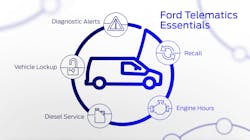Ford expands fleet telematics offerings to all makes and models
Ford is expanding its Ford Telematics system so companies can use the product’s fleet monitoring services on all its vehicles, regardless of make and model, the company announced at the 2021 Work Truck Show.
Noting the OEM’s 45% market share across Class 1 to Class 7 commercial vehicles, Philip Podgorny, Ford’s general manager of commercial and government sales, said it’s clear where the company is headed: “Ford owns work,” he said during a virtual press conference on March 8. “We have no plans to cede to startups or existing competition. And we’re investing heavily in the commercial space with the new connected products, dealer services, customer support, hardware and software solutions to help lower total cost of ownership and achieve maximum uptime.”
With Ford Telematics, fleet managers can now gather, view and monitor data from all their vehicles, regardless of manufacturer. With this expanded functionality, fleets can analyze all of their fleet vehicles in one dashboard, which Podgorny said would improve uptime.
Ford Telematics is also releasing new tools within the product to give businesses more flexibility to manage their fleets, including tools to manage driver behavior, performance and compliance goals.
“When building solutions for small, medium and large commercial fleet customers, our focus is providing fleet managers with meaningful, intelligent and actionable insights about their fleet,” said Alex Purdy, Ford’s director of business operations for enterprise connectivity, during the press conference on the first day of NTEA’s Work Truck Show, which is being held virtually this year. “Knowledge is power. And with a connected fleet, our full suite of products allow fleet managers to see what's going on in real-time, driving productivity improvements across their business.”
Fleets can leverage the new capabilities on most non-Ford vehicles by using a plug-in device that connects to each vehicle with a wiring harness that leaves the OBD II port available for use. Additionally, this expanded functionality is provided as part of the regular subscription cost for Ford Telematics.
Fleet customers with electric vehicles also have access to an electric vehicle telematics dashboard, which provides features such as electric-vehicle data, charging reports, and web-based pre-conditioning to optimize battery efficiency.
Managing drivers
Ford Telematics offers a fleet-wide driver behavior dashboard that includes individual driver scores designed to help managers monitor and improve performance. The driver behavior dashboard gives managers a survey of how their vehicles perform, providing information about trends that involve harsh braking or acceleration, speeds driven over posted limits and/or fleet-set thresholds, seatbelt use, and idling time. The personal driver score also gives managers details on specific drivers’ behavior on the road, which provides coaching opportunities.
“Because there’s so much data at our fingertips, it’s critical to give fleet managers a clear and simple way to gain insight into their business,” Purdy said. “Ford Telematics gives managers an easy way to break down performance trip by trip, driver by driver, so they can focus on running a safe, productive fleet.”
The telematics system also features severe incident notifications, alerting fleet operators when a fleet vehicle’s airbag was deployed. E-mail and in-app alerts can relay the driver involved, the location of the crash, and the time. Vehicle misuse notifications enable managers to set operating hours and receive notifications if their vehicles are misused during off-hours.
Improving uptime
Purdy said that the new telematics features are focused on productivity and uptime to help fleets manage the total cost of ownership. “Over the last year, we've heard from many of you about how important proactively managing your vehicle health is to controlling the cost of operating your business,” he said. “We listened, and I'm pleased to announce we're making the vehicle health tools complimentary across Ford's commercial vehicle range.”
The free level of service for commercial customers will be available in the second quarter of 2021. Ford Telematics Essentials offers access to vehicle health insights such as odometer readings, diagnostic trouble code and information around oil life, engine hours, and recalls. Later this year, this service will also allow fleets to digitally track and plan maintenance or repair services with local dealers.
“We're committed to improving your uptime, and the complimentary vehicle health tools through Ford Telematics Essentials are an important part of making good on the Ford promise,” Purdy said. “Another way we're helping to improve uptime is by building over-the-air update functionality into our vehicles starting with this year's F-150.”
Beginning with the 2022 F-150, Ford vehicles equipped with this technology can receive updates and repairs wirelessly, reducing the need to visit a dealer for maintenance. These updates can be delivered in the background or scheduled by the driver.
Future Fords
Podgorny also shared a glimpse into Ford’s future, noting its plans to invest $29 billion in electric and autonomous vehicle development over the next four years. “We will not yield this ground to anyone,” he said.
He noted that the electric Ford Mustang Mach-E hit showroom floors late last year. On the commercial side, a new electric e-Transit is set to arrive later this year, and an electric F-150 is slated to be available by the middle of 2022.
Podgorny said the new electric vehicles could create more cost savings for fleets. The scheduled maintenance costs of the new e-Transit are estimated to be 40% less than the average maintenance costs for the gas-powered version.
“Ford is just getting started,” he added, “with more all-electric products on the horizon and engineered for uptime, all supported by fleet charging solutions for home, public and depot, including the largest public charging network in America with over 16,000 charging stations nationwide.”
About the Author
Josh Fisher
Editor-in-Chief
Editor-in-Chief Josh Fisher has been with FleetOwner since 2017. He covers everything from modern fleet management to operational efficiency, artificial intelligence, autonomous trucking, alternative fuels and powertrains, regulations, and emerging transportation technology. Based in Maryland, he writes the Lane Shift Ahead column about the changing North American transportation landscape.

